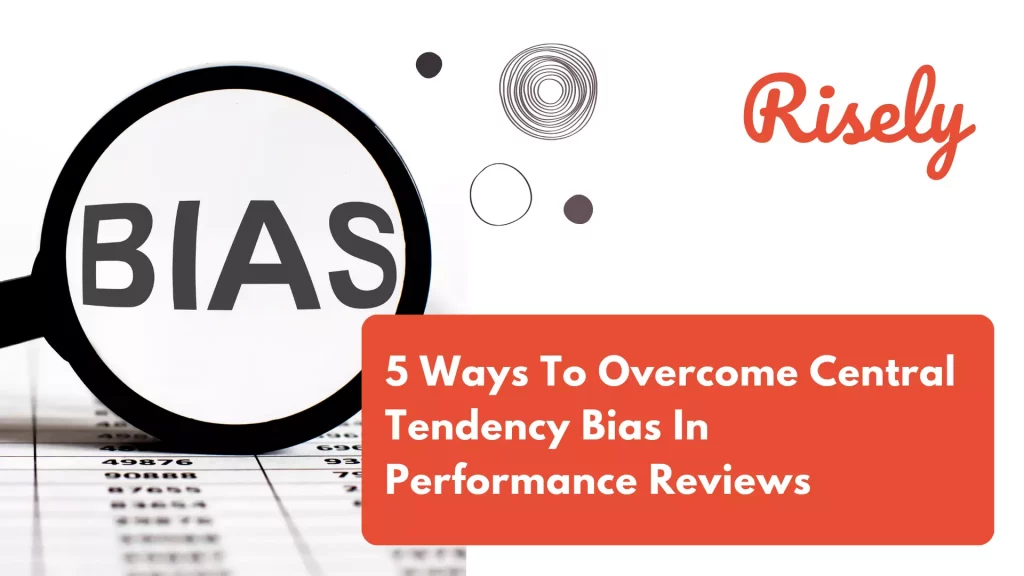Have you ever been seen a performance review that felt off-kilter? Maybe the ratings were way too high, or the feedback was negative even though the employee had done a great job. Maybe the person giving the review didn’t know the employee very well. This can be due to central tendency bias – a psychological phenomenon that often affects performance reviews.
To make matters worse, central tendency bias is often invisible to those affected. However, there are ways to overcome central tendency bias and give accurate performance reviews that reflect what’s happening on the ground.
Let’s explore!
What Is Central Tendency Bias?
In simple terms, central tendency bias is the tendency of people to rate most items towards the middle of the scale. Managers often use central tendency bias when conducting performance reviews. Effectively, in the context of performance reviews, most people are given average scores. For example, if an employee has achieved a rating of 4 out of 5 stars on their last performance review, managers would likely give the average score as 3.5. However, if the same employee had only achieved 2 out of 5 stars on their last performance review, they may receive a rating of 3 in this scenario. This is because central tendency bias dictates that most ratings will be towards the middle – meaning that it’s more probable for someone to receive a rating close to or at 3.5 than for them to receive a rating closer to or at 1. Resultantly, we can see that the entire purpose of conducting performance reviews gets diluted due to moderation. Learn more about biases that impact managers at work: How To Overcome The 10 Most Common Manager Biases At Work?How Does Central Tendency Bias Impact Performance?
Central tendency bias is a tendency for reviewers to focus on the average results of a group rather than individual results. This can hurt performance reviews as employees may feel they do not need to perform at their best to be considered average. As we have noted, the central tendency bias will cause all performance reviews to be skewed towards the middle. When evaluations are based on averages, people who perform best may not feel appreciated. This will directly impact their motivation. Conversely, underperforming employees may receive consistently better feedback – even if they have not done a great job. These people will miss out on the opportunities for improvement that an honest review could have provided. All in all, the benefits to employees from performance reviews are severely curtailed when they are not carried out properly. It can lead to feelings of stress and anxiety, which can, in turn, affect employee productivity. Additionally, it’s often difficult for an individual to know how they stack up against the average performer because their experience may be unique. As a result, the growth of a team stagnates. Check out the comprehensive guide to performance reviews!Other Interesting Reads
Five Ways To Overcome Central Tendency Bias In Performance Reviews
A smart manager needs to provide accurate feedback to promote the growth of their team. Closing the performance gaps between employees can be a challenge. To help overcome central tendency bias in performance reviews, try the following strategies:Recognize And Acknowledge The Bias
Biases, by their very nature, are hard to spot. They are common and normal in managers too. Often, biased people may fail to realize that their intuitions have guided them. However, acknowledging their existence might be hard. Therefore the process of overcoming begins with recognition and acknowledgment. You will need to build awareness about the existence and impact of central tendency bias. First and foremost, awareness is key. If managers are aware of the issue and understand how central tendency bias can distort their reviews, they can take steps to mitigate the risk. You can take up examples from your environment to highlight the instances. Further, understanding the detrimental impact is also crucial.Prioritize Objectivity Over Subjectivity
Managers can succumb to a subjective bias in the review process by emphasizing their personal feelings and opinions over objective facts. Systematic reviews, which include data points such as goals and outcomes, help reduce this type of bias. Moreover, managers might give average ratings to almost all employees to remain in favor of everyone, as they could fear backlash or potential disengagement from employees who do not get higher ratings. Therefore, managers must adopt an impartial and objective approach.Use Technology
Technology has the potential to reduce bias in decision-making and performance reviews. For instance, 360° feedback tools can capture all aspects of an employee’s work, including their strengths and weaknesses. Managers can use this information to give employees objective ratings rather than relying on subjective judgments. Furthermore, automatic tracking tools help managers quickly see whether employees are meeting goals or not. These tools also provide data points such as timeliness and quality for objectivity in the review process.Involve Others In Performance Reviews
Managers should involve others in the performance review process to ensure that their judgment is under check. This includes employees’ supervisors, team members, and peers. A 360-degree review is less likely to suffer from similar biases from all directions. Involving others in the review helps counteract any subjective bias that could exist. Furthermore, it allows for objectivity when compiling ratings and makes it easier for managers to provide impactful and constructive feedback. Finally, a collaborative goal-setting approach will help gain acceptance for the reviews and reduce the fear of backlash from employees rated at the extreme ends.Modify Your Scale For Reviews
Managers can make several changes to the scales they use to reduce the scope for central tendency bias. For instance, instead of a 5-pointer, they can see a 4-point scale. This won’t allow them to be neutral. But instead they will have to identify the employee as high performing or underperforming. Otherwise, managers can also switch to a relative scale, where they rank each employee along the same metric. Again, this reduces the scope for bias as not all employees can be the best or worst performing. Further, ensure that the metrics and standards for measurement are clear. Managers are more likely to give average ratings when they do not understand the issue. There are several ways managers can reduce the scope for central tendency bias in their reviews. By involving others, changing scales, and being clear about standards for measurement, managers can help ensure that objective ratings are compiled. You can mix a few of these techniques to improve the accuracy of your results.Conclusion
Managers and leaders have hundreds of challenges. Biases that creep into decision-making and reviews present a huge hurdle in generating the highest efficiency possible. But worry not! We are here to provide you with solutions to all your management challenges. In this blog, we’ve outlined the effects of central tendency bias on performance reviews and given five ways to overcome it. By understanding the bias and taking steps to overcome it, you can help to ensure that performance reviews are fair and accurate.Improve your constructive feedback skills to raise your team’s productivity.
Get the free constructive feedback toolkit to create a master plan that makes constructive feedback easy and effective.






